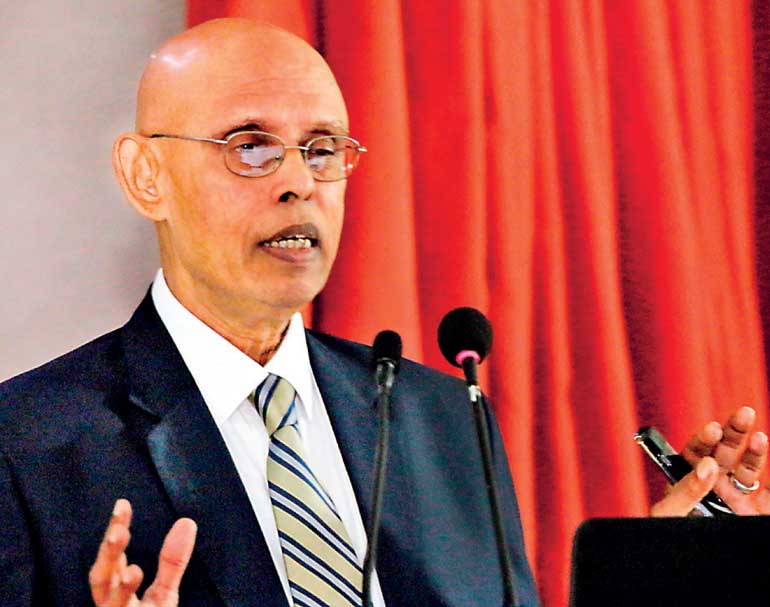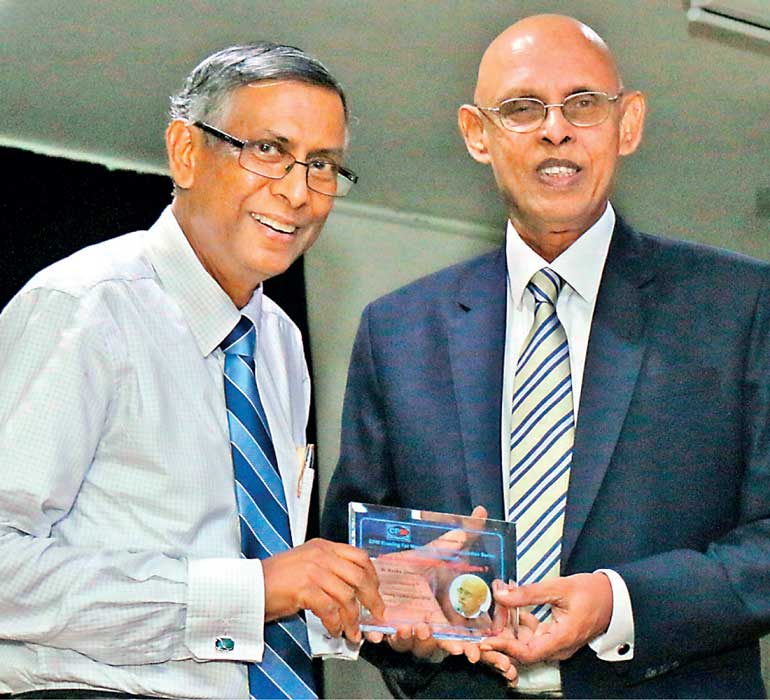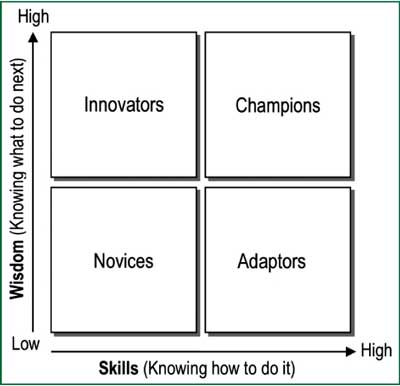Monday Mar 17, 2025
Monday Mar 17, 2025
Thursday, 23 June 2016 00:00 - - {{hitsCtrl.values.hits}}

CPM Sri Lanka Education and Training Committee Head Samantha Rathnayake (third from left) moderates the panel discussion titled ‘How Innovative are our managers’ as part of the Institute of Certified Professional Managers Evening for Managers program. Others from left are The Kingsbury Director HR Salome Senaratne, Daily FT Editor Nisthar Cassim, key presenter Dr. Asoka N. Jinadasa, PIM Senior Consultant Dr. Trevor Mendis and CMA/CPM representative and public sector expert and management consultant M.M.M. Rizley

Dr. Asoka N. Jinadasa makes his presentation

CMA Sri Lanka President Prof. Lakshman R Watawala presents a memento to key presenter Dr. Asoka Jinadasa
By Dr. Asoka Jinadasa
The success of every organisation depends on its ability to change faster than its operating environment. In today’s highly volatile world, the insanity of ‘doing the same thing and expecting different results’ can be restated as ‘doing the same thing and expecting the same results!’
Therefore, managers need to use innovative concepts founded on creative thinking to continuously create the future while  consolidating the present. However, in today’s fast-paced world, traditional innovation is not enough. We need to innovate quickly, efficiently, and with less risk.
consolidating the present. However, in today’s fast-paced world, traditional innovation is not enough. We need to innovate quickly, efficiently, and with less risk.
Instead of unfocused thinking ‘outside the box’ we need to focus on defining a broader box to find new ways to attain specific objectives within specific timeframes. This article present insights into unleashing the inborn creativity lying mostly dormant within every manager and channelling it into an innovation process.
Why the sudden focus on innovation?
The answer is based on the second law of thermodynamics. It states that things tend to move naturally from a state of order to a state of disorder. It also states that matter and energy in the universe degrade to an ultimate state of inert uniformity.
Organisations that are struggling to survive display this state of inert uniformity in their culture, personified by the stagnant attitudes and passive behaviours of their leaders. Even worse, they treat employees as replaceable resources that can be disposed of when no longer needed.
In sharp contrast, employees at all levels in forward-thinking organisations are encouraged to balance their daily focus on achieving targets with an evaluation of associated risks and opportunities arising from rapid changes in their operating environments. Such organisations quickly adapt to change by fostering a mind-set of creativity and innovation among their entire workforce.
Creativity or innovation?
Creativity is the process that combines two or more different ideas or things to create something totally new; Innovation is about using such new concepts to institute change geared to achieving a specific objective.
Creativity is founded on divergent thinking, which means seeing things from many different angles and finding many different solutions to any given problem. Innovation is founded on convergent thinking, which weighs the different solutions and selects the optimum one for achieving a specific objective. Creativity is more an abstract ‘right-brain’ activity while innovation is more a rational ‘left-brain’ activity.
Balancing creativity and rationality
All children are born with an amazing ability for divergent thinking, which is the foundation of creativity. In a study of 1,500 kindergarten children, 98% scored at genius level in divergent thinking. When the same children were tested five years and ten years later, their divergent thinking ability had deteriorated sharply due to their focus on passing exams that demand convergent thinking.
Creativity is thus not a special gift possessed by a lucky few. However, creativity isn’t a switch most of us can turn on at will, so the key to becoming innovative is to awaken our dormant creative talents. The best way is by refocusing our attention on neglected right-brain creative activities such as music, dancing, drawing, and creative writing.
Another key factor that hinders our creative ability is a mind-set that produces a fear of failure. This is the greatest obstacle to implementing bold new changes in the workplace. A fear of failure stems from the type of mind-set we have acquired, based on our past experiences.
‘Being good’ vs. ‘Getting better’ mind-set
Our attitude towards any attempts to initiate change is governed by the kind of mind-set we acquired in our early days. This broadly falls into one of two categories: ‘being-good’ or ‘getting-better’. A being-good mind-set makes us see everything as an opportunity to show how good we are when compared to others, with any failure seen as not being good enough. So we tend to give up easily when things get tough, rather than taking the risk of trying and failing. We mostly have a being-good mind-set, since the love of parents and teachers had to be won through successful efforts, while any courageous but unsuccessful attempts were condemned as failures.
In contrast, a getting-better mind-set makes us see everything as a chance to learn and grow, and we see every setback as a learning opportunity. When we cultivate a getting-better mind-set, we accept risks, are more willing to try new things, and are less afraid of failure. We used this mind-set to learn to ride a bicycle in our early days, despite the risk of falling off and looking inferior to others who were able to ride.
Innovation thus requires a shift from the typical being-good mind-set to a getting-better mind-set that can deal with setbacks, by seeing them as learning opportunities on the path to ensuring organisational success.
The Wisdom-Skills matrix of success
In our fast-paced world, organisational success depends on two decisive factors: Wisdom (knowing what to do next) and Skills (knowing how to do it). Wisdom stems from a mix of intuitive insights gained mainly through ‘inner soft skills’ (personal energy, self-confidence, mindfulness) and ‘outer soft skills’ (ability to communicate with and influence others).
Skills mainly relate to ‘hard skills’ (work-related knowledge, skills, tools, processes). Without wisdom, a person or organisation could address wrong issues and solve irrelevant problems. Without skills, a person or organisation will not be able to do what needs to be done.
Innovators vs. Adaptors
The wisdom-skills matrix also provides a broad framework for identifying the creative styles of different people. People who are low on both wisdom and skills could be novices who need training in both hard and soft skills, or people whose interests lie outside their current areas of work.
Champions with both Wisdom and Skills have fully developed hard and soft skills. They are powerful change agents, who can lift others to champion level by fostering wisdom and skills backed by personal energy, motivation and engagement. Individuals who are high on wisdom but low on skills are typically Innovators, while those who are low on wisdom but high on skills are typically Adaptors.
Adaptors prefer more structured problem-solving methods, and are most comfortable when everyone is in agreement about the process and the solution. They are more likely to find creative solutions to problems by working within the current system as opposed to developing a completely new one. In contrast, Innovators are at ease with a less structured problem-solving approach and don’t view a lack of consensus as an obstacle to finding a new answer. They tend to look beyond the status quo for solutions, even to the point of overlooking positive aspects of the current system.
Neither style is more creative, or better at problem solving or decision making. Depending on the situation, one style may be more adept at solving the problem at hand in an optimum manner. What is important is recognising the creative style of each person and helping him or her to contribute within their creative framework, depending on the required approach.
‘Demand-pull’ vs. ‘Supply-push’ approach
The ‘demand-pull’ approach to innovation is about finding customers’ challenging problems and then figuring out how your organisational expertise can provide new solutions. It is determined also by customers’ imagination and willingness to take risks with any unproven new concept, such as using touch pads instead of conventional keypads. The ‘supply-push’ approach involves developing new technology and then finding or creating a market when an identifiable market does not yet exist.
Choosing between a demand-pull and a supply-push approach for innovation requires weighing the trade-offs. If you choose the former, you risk missing out on technologies for which markets have not yet emerged. If you choose the latter, you may create technologies that never find a market. Both approaches involve starting off with a creative new idea geared to a specific strategic objective.
A framework to validate creative ideas
You can use a six-dimensional framework to check the innovation potential of any new idea:
Business Model and Strategy: Does the idea require a realignment of the business model and business strategies, and if so would that be acceptable?
Competitive Advantage: Does the idea contain a USP (unique selling proposition) to strengthen the competitive position of the enterprise in its operating environment?
Business Alignment: Does the idea relate to the current and future business directions of the enterprise?
Business Value: What key benefits would the execution of the new idea bring to the enterprise in terms of revenue, sustainability, image, and so on.
Customer Value: Does the idea offer superior value to the present or future target customer groups in meeting their expectations?
Execution: Can the idea be viably converted to a product or service, by leveraging the core competencies and resources of the enterprise?
If a new creative concept meets the above six criteria, the next step is to check how it fits into an innovation strategy.
Creating an innovation strategy
Organisations rarely articulate strategies to align their innovation efforts with their operational objectives. An innovation strategy must be closely linked to an organisation’s operational framework and core value proposition. It requires managers and employees at all levels to review their daily activities from new angles. It must find the right balance between how much to invest in technological innovation and how much to invest in operational innovation. A robust innovation strategy should answer the following three questions:
1. How will your innovation create value for customers?
Unless innovation induces present or targeted customers to pay more, saves them money, or provides some larger societal benefit like improved health or cleaner water, it will not create value for customers. Innovation might make a product perform better, or make it easier to use, more reliable, more durable, less costly, and so on. Choosing what kind of value your innovation will create and then sticking to that theme is critical. If you want to invent a future that doesn’t exist, skip the market research. Instead, you have to understand what people are expecting, and completely reimagine it using divergent thinking.
2. How will you capture a share of the value your innovations generate?
Value-creating innovations attract imitators as quickly as they attract customers. Moreover, if the suppliers, distributors, and other stakeholders required to deliver an innovation are dominant enough, they may have sufficient bargaining power to capture most of the value from that innovation. You must consider what complementary assets, capabilities, products, or services could prevent customers from defecting to rivals. Once these key components are designed into a customer’s system, the customer will incur switching costs for defecting to another supplier. One of the best ways to preserve bargaining power and blunt imitators is to continue to invest in innovation.
3. What types of innovations will allow you to create and capture value, and what resources should each type receive?
In the past couple of decades, we have seen a multitude of companies (Netflix, Amazon, LinkedIn, Uber) master the art of business model innovation. When thinking about innovation opportunities, you have to choose how much of effort to focus on technological innovation and how much to invest in operational model innovation. What is even more important is creating an organisational culture that nurtures innovation.
Creating an innovation culture
Innovation is a tool that visionary organisations use to achieve distinctive and sustainable strategic goals. It stems from the new thinking found in the thousands of decisions that are made every day in different departments within an organisation. Its aim is to achieve higher levels of results that would not be obtained through conventional continuous improvement. Innovation is driven and guided by a corporate vision that is unique, relevant and clearly understood by its leaders, employees, business partners and customers (not vague as ‘to be the best’ but specific as ‘to deliver the world’s safest cars’.)
An innovation culture requires an environment of trust so employees trust each other, know they can take reasonable risks without fear, know that outrageous ideas are welcome, and know that their managers will champion their ideas and credit them for those ideas instead of stealing them. Ideally, there should be no ‘Chief Innovation Officer’. Having one would send wrong signals to the staff, since innovation must be ingrained in the mind-sets and behaviours of everyone for which there is no specific leader. Innovation leaders can only facilitate this process. They are different from other leaders within the organisation in that they do not have direct authority over those who make innovation a reality.
Conclusion
Innovation is a process that is fed by creative ideas from the entire workforce and their managers. This can only happen if the top management of the organisation is fully committed to supporting ongoing transformational change. Most organisations have a lot of creative employees and managers with new ideas about streamlining their internal processes to meet the expectations of their stakeholders. Encouraging them to come up with creative new ideas and implementing the most innovative ones is the only way to sustain organisational success in increasingly unpredictable operating environments.
[This brief evening presentation was initiated by Prof. Lakshman Watawala (President of CPM). It was followed by a panel discussion moderated by Samantha Rathnayaka (Head of the E&T Committee of CPM) with the participation of Dr. Trevor Mendis (Senior Management Consultant of the Postgraduate Institute of Management), Salome Senaratne (Human Resources Director at The Kingsbury Hotel), Nisthar Cassim (Chief Editor of the Daily FT), and M.M.M. Rizley (Management Consultant).]
Discover Kapruka, the leading online shopping platform in Sri Lanka, where you can conveniently send Gifts and Flowers to your loved ones for any event including Valentine ’s Day. Explore a wide range of popular Shopping Categories on Kapruka, including Toys, Groceries, Electronics, Birthday Cakes, Fruits, Chocolates, Flower Bouquets, Clothing, Watches, Lingerie, Gift Sets and Jewellery. Also if you’re interested in selling with Kapruka, Partner Central by Kapruka is the best solution to start with. Moreover, through Kapruka Global Shop, you can also enjoy the convenience of purchasing products from renowned platforms like Amazon and eBay and have them delivered to Sri Lanka.
Discover Kapruka, the leading online shopping platform in Sri Lanka, where you can conveniently send Gifts and Flowers to your loved ones for any event including Valentine ’s Day. Explore a wide range of popular Shopping Categories on Kapruka, including Toys, Groceries, Electronics, Birthday Cakes, Fruits, Chocolates, Flower Bouquets, Clothing, Watches, Lingerie, Gift Sets and Jewellery. Also if you’re interested in selling with Kapruka, Partner Central by Kapruka is the best solution to start with. Moreover, through Kapruka Global Shop, you can also enjoy the convenience of purchasing products from renowned platforms like Amazon and eBay and have them delivered to Sri Lanka.